Asia-Pacific EMC (2016 APEMC in
China)
By En-Xiao Liu, Lijun Jiang, 2016 APEMC TPC Chairs
IEEE EMC
Magazine, vol. 5, no. 2, pp. 84- 88, 2016
Overview
The 7th Asia-Pacific International Symposium on Electromagnetic Compatibility & Signal Integrity and Technical Exhibition (2016 APEMC) has been successfully held in Shenzhen, China, during May 18 to 21, 2016. Shenzhen is selected to host the 7th APEMC because of its strategic adjacency to Hong Kong, its pioneering status of being China’s Window to the World, and its fabulous facilities and being home of world-class electronic industries and research centers. The APEMC symposium is an important forum for world-wide EMC communities with a primary focus in the Asia-Pacific region.
The 2016 APEMC was jointly organized and technically co-sponsored by Zhejiang University, IEEE EMC Society, South University of Science and Technology of China , Hebei University of Technology, National University of Defense Technology, CEMEE Lab China, Antenna and Microwave lab China, China Electrotechnical Society,
2016 APEMC received close to 500 submissions from 31 countries and regions. 388 papers are accepted and presented at the conference. Besides 16 regular technical sessions, it also included two keynote speeches, three plenary talks, one industry Luncheon talk, 14 special sessions, 8 workshops, 8 tutorials, 19 invited papers, and 1 industry forum. Four embedded topical mini-symposiums covered hot EMC-related areas: Integrated Circuit (IC) EMC, Wireless Power Transfer Technologies, Smart Grid & Power Electronics EMC, and Biomedical Electromagnetics. 2016 APEMC covered a full scope of EMC: from IC to system, from electronics to bioengineering, from measurements to modeling, from traditional topics to emerging technologies, from standards and regulations to EMC paper writing. 2016 APEMC has attracted 472 delegates including 169 students, and 700 exhibition visitors.
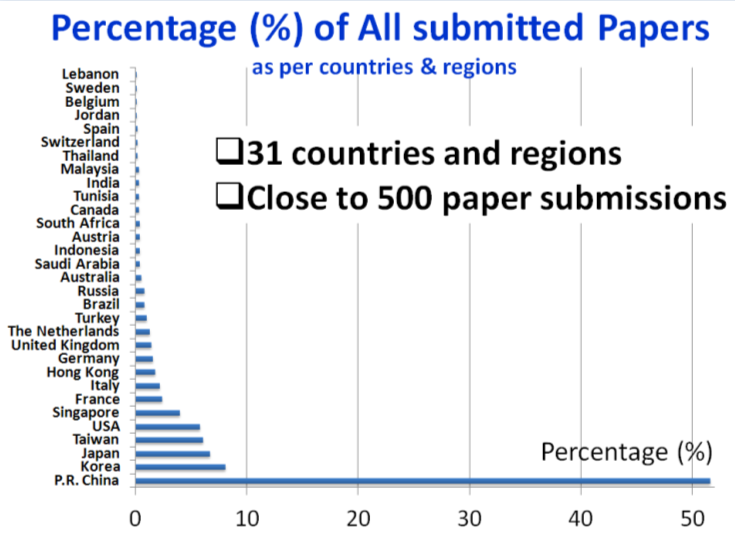
Breakdown of all submitted papers according to countries/regions
Professor Er-Ping LI, General Chair of the 2016 APEMC, addressed the symposium participants at the Opening Ceremony in the morning of 19 May. Subsequently, Professor Lijun JIANG from University of Hong Kong, TPC chair of the 2016 APEMC, gave his speech on behalf of the technical committee. The 2016 APEMC was thereafter declared open by Professor Shi-Yi CHEN, President of South University of Science and Technology of China, Member of Chinese Academy of Sciences. In his opening address, he highly praised all EMC researchers for being always riding throughout the Information and Communication Technology (ICT) waves: the Internet, the Mobile Internet, the Internet-of-Things (IoT), and Artificial Intelligence and Robotics. Two eminent scientists delivered their keynote at the opening ceremony: Dr. Frank Leferink, Thales Group, the Netherlands, gave a speech titled “Interfered Technology: A Radiant Future”; Dr Li Li, Principal Scientist, from Huawei Technologies Co. Ltd, Shenzhen, gave a speech titled “The Key Technologies and the Challenges in the Development of 5G Communication.”
 |
 |
 |
| Professor Er-Ping, General Symposium Chair, delivered his opening address to the conference delegates at the opening ceremony of the 2016 APEMC. | Professor Lijun JIANG, TPC chair, gave his speech on behalf of the technical program committee. | Professor Shi-Yi CHEN, President of South University of Science and Technology of Chin and Member of Chinese Academy of Sciences, declared open of the 2016 APEMC. |
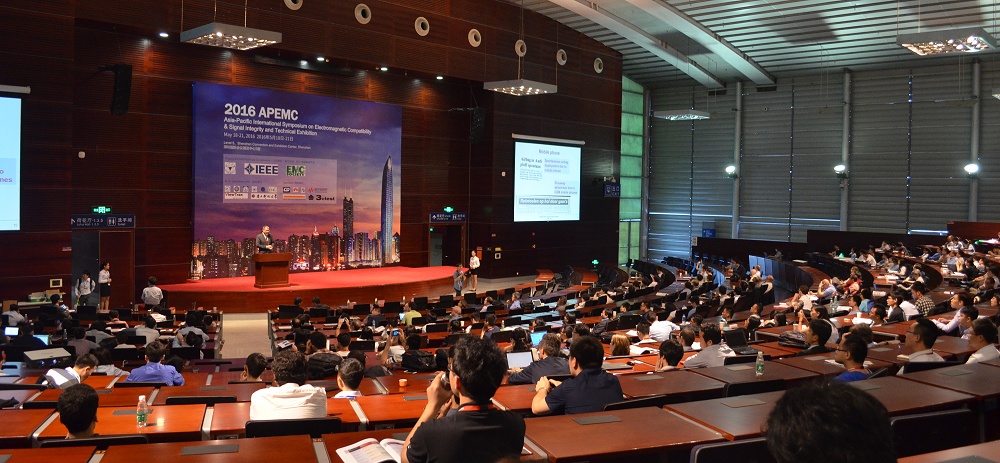
Dr. Frank Leferink, Thales Group, the Netherlands, delivered his keynote speeches at the opening ceremony in the morning of 19 May.
Plenary Talks and Technical Sessions
Three eminent scientists also delivered plenary speeches in the afternoon of 19 May and morning of 20 May during the technical sessions. They are Professor Weng Cho Chew from University of Illinois at Urbana-Champaign; Professor Tzong-Lin WU from National Taiwan University; and Professor Jun Fan, from Missouri University of Science and Technology.

Professor Weng Cho Chew was giving his plenary speech to a full house in the afternoon of 19 May.
 |
 |
| Professor Tzong-Lin WU (left) and Professor Jun Fan (right) gave their plenary talk on 20 May. | |
Five parallel sessions were conducted each day from 18 to 21 May 2016. The first day of the conference was dominated by workshops and tutorial with a few technical paper sessions. The rest three days were mainly occupied by technical paper sessions mixed with workshops, tutorials, and topical symposiums.

Conference delegates listening to a talk at a technical session.

Participants
at a poster session.
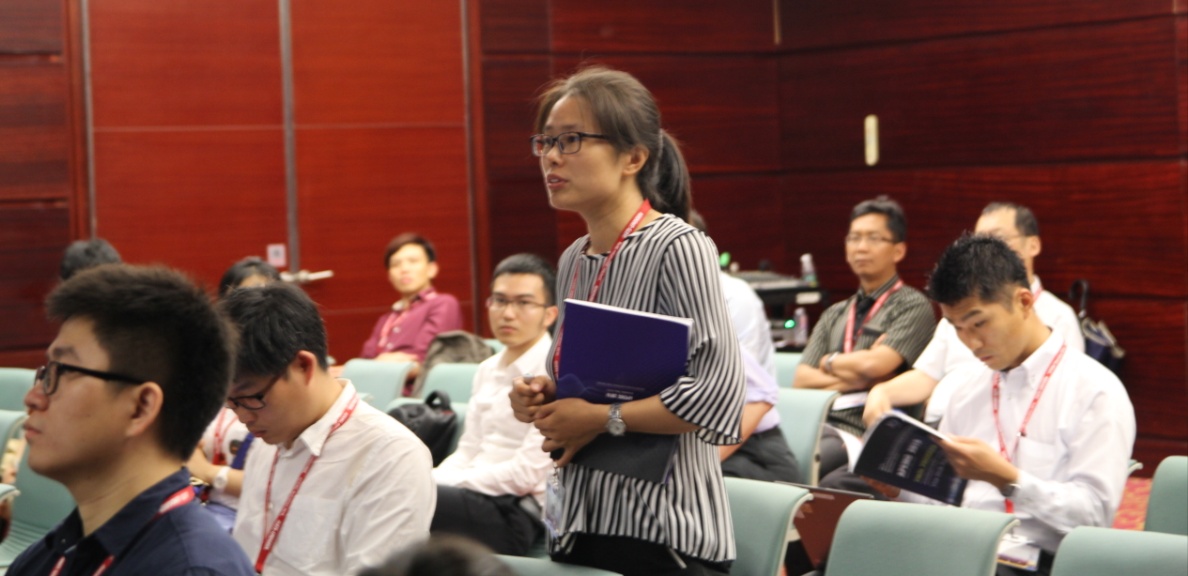
The
Q & A session was still fresh with vigor at a technical session
on Saturday, the last day of the symposium.
Banquet dinner and award presentations
The highlight among all 2016 APEMC social events was the banquet dinner cum award presentations, held at the Ball Room, Maco Polo Hotel. Following Professor Er-Ping Li’s toast, an exciting FOU drum beating performance in colorful ancient Chinese costumes was performed. FOU, a special type of ancient drum, was a percussion instrument used in China about 2700 years ago. FOU was usually made of clay or copper. If the conference delegates were to live 2700 years ago, they would use small FOU as the containers to hold wines at the banquet dinner. This same performance has been conducted in the opening ceremony of the 2008 Beijing Olympic.
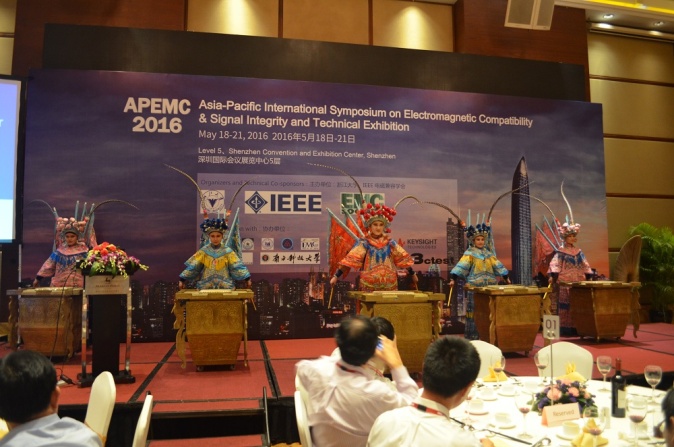 |
 |
| Conference delegates enjoyed the Chinese FOU drum beating performance right before the dinner. | |
On
one hand, the 2016 APEMC won’t be able to succeed comfortably
without the generous support by many sponsors, Compliance Direction
System Inc, Huawei Tech Ltd, CST, Keysight, AR RF/Microwave
Instrumentation and 3Ctest. On the other hand, a wonderful
symposium will never complete without awards. Prof. Wen-Yan Yin, Award
Chair, introduced to audiences how the best papers were shortlisted and
selected. Professor Marcello D’amore, Sapienza University of
Rome, gave out the three best symposium paper awards. As always, every
APEMC gives out best student paper awards. This year’s best
student paper awards are generously supported by Huawei. Mr. Ronghua
Zhong, Director of Huawei Technologies gave out three best student
paper awards.
Among all the APEMC delegates, there is one group of people who are
holding the future of EMC - the young researchers. For the first time
in the short history of APEMC, this year’s APEMC has
specially created Young Scientist Awards to recognize outstanding young
EMC researchers. Dr. Perry Wilson and Prof. Er-Ping LI presented the
awards to 8 young scientists aged 38 years and below. They are Dr Qi
Wu, Dr Flavia GRASSI, Liang Zhou, Dr Henglin Chen, Dr Zhanqing Yu, Ms
Haiyan Xie, Dr Yuichi HAYASHI, and Chung-Hao TSAI.
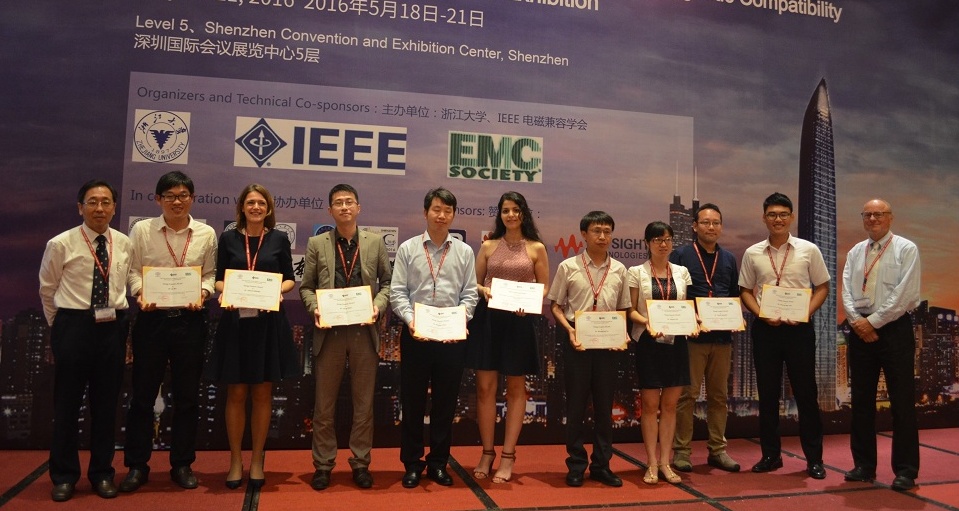
APEMC Young Scientist Awardees poised for a group photo with Prof. Er-Ping LI and Dr. Perry Wilson.
All successful symposiums have one thing in common --- an excellent organising team. Prof. Er-Ping LI first presented a token of appreciation to last year’s APEMC Symposium Chair, Prof. Tzong-Lin Wu, National Taiwan University; then he proceeded to present token of appreciations to the 2016 APEMC organizing team.

The 2016 APEMC organizing committee took a group photo at the banquet dinner on 20 May.
EMC Society
board hosted
luncheon
On 18 May, IEEE EMC Society board hosted a luncheon meeting. Don
Heirman was delegated by Frank Sabath, president of the IEEE EMC
Society, to head the IEEE EMC board delegates to further engage and
discuss with APEMC organizers. Through the luncheon meeting, EMC
society delegates and Asia Pacific EMC leaders got to know each other
more. The future plans of APEMC were discussed over the meeting, and
the relation between APEMC and other regional or national EMC
symposiums were also discussed constructively. Attendees were thankful
to the small gifts from the IEEE EMC Society.
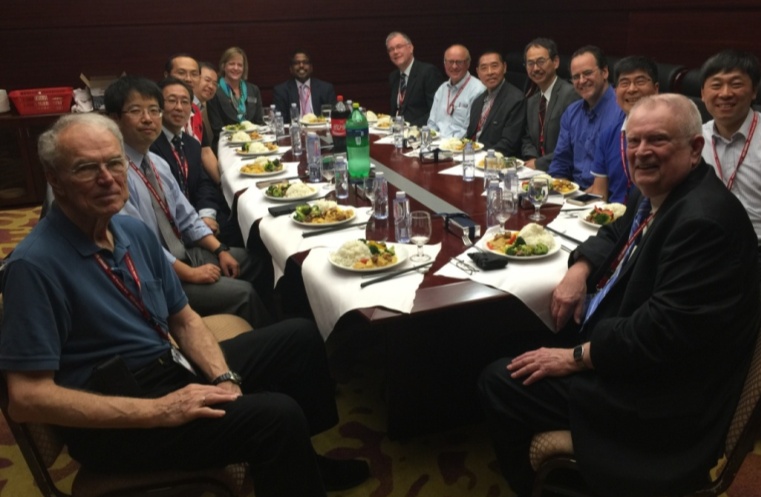
Attendees at the luncheon from left: John Norgard(IEEE EMCS), Lijun Jiang(University of Hongkong), Er-Ping Li(APEMC), Enxiao Liu(A*STAR, Singapore), Joungho Kim(KAIST, Korea), Janet O’Neil(EMCS), Vignesh Rajamani(EMCS), Frank Leferink(Netherlands), Perry Wilson(EMCS), Peter Leong(City University of Hong Kong), Osami Wada(Kyoto University, Japan), Mike Violette(EMCS), Tzong-Lin Wu(National Taiwan University), Jinliang He(Tsinghua University), and Don Heirman(EMCS).
Conclusion
The 2016 APEMC was concluded in the late afternoon of Saturday, 21 May.
The organizing committee sincerely thanks all the participants,
speakers, authors, paper reviewers, sponsors, exhibitors, technical and
advisory committee members and volunteers for making 2016 APEMC a big
success!
See you all at the
2017 APEMC
in Seoul, Korea, and 2018 joint IEEE EMC
and APEMC in Singapore!

Last update: 5
Nov 2016 by APEMC webmaster